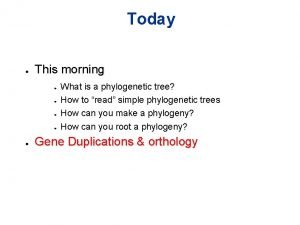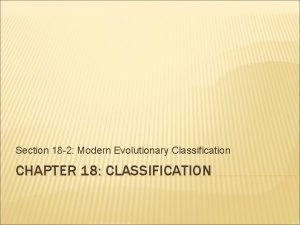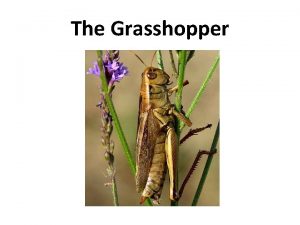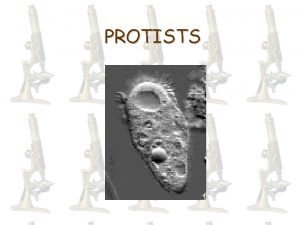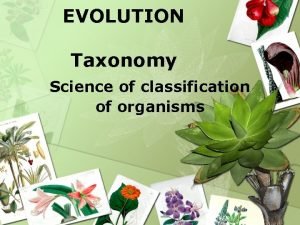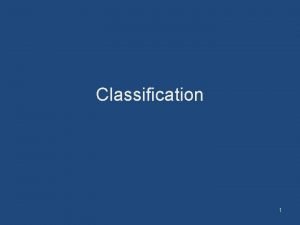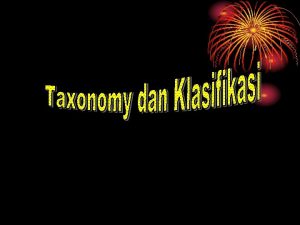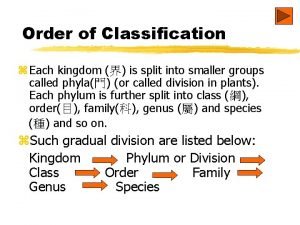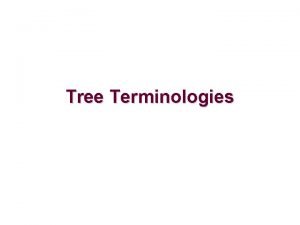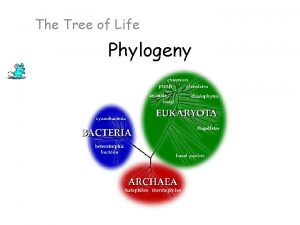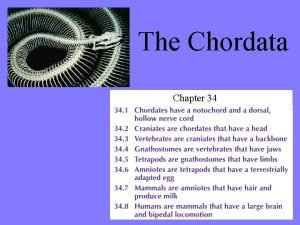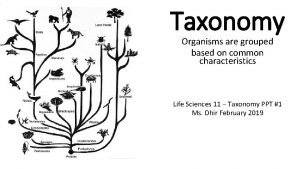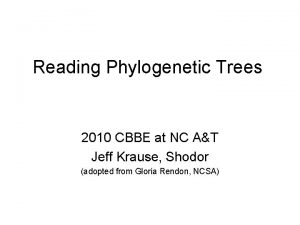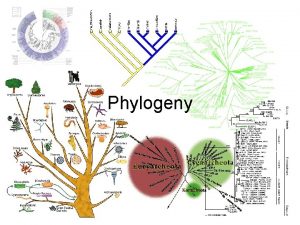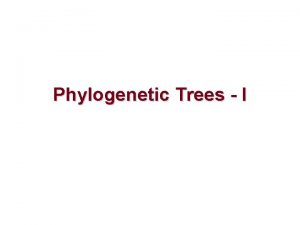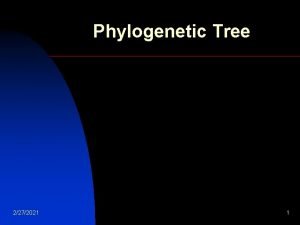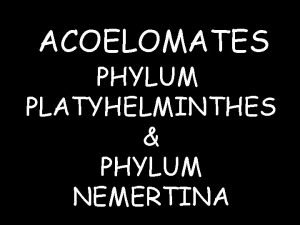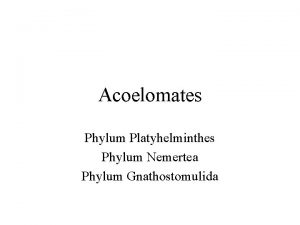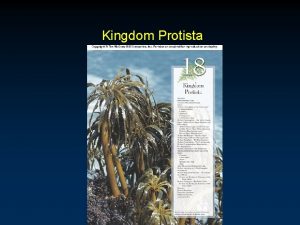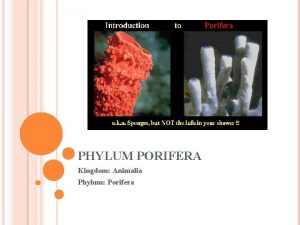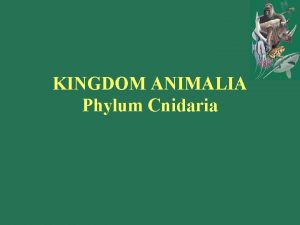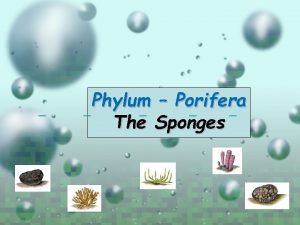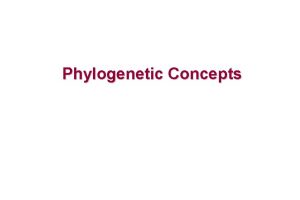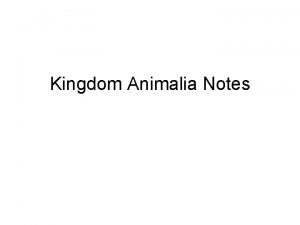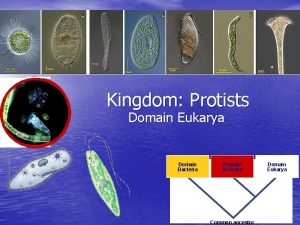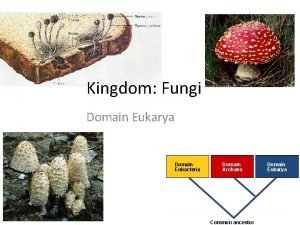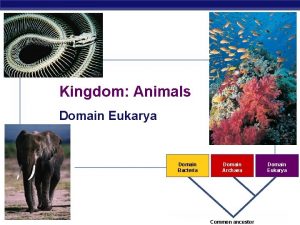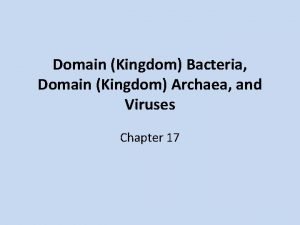Finishing Taxonomy The Phylogenetic Tree Domain Kingdom Phylum























- Slides: 23

Finishing Taxonomy

The Phylogenetic Tree Domain Kingdom Phylum (sub-phylum) Class Do Kangaroos Prefer Chocolate Or Fruit Generally Speaking? Order Family Genus Species

The 3 Domains

Bacteria u. Prokaryotic u. Unicellular u. Some u. Mostly of the first life forms on Earth found in 3 shapes – spheres, rods and spirals u. Contains a cell wall (amino acids) u. Ribosomes u. Eg. (70 S sedimentation rate) Gut flora, syphallis, Lactococcus

Archae u. Prokaryotic u. Unicellular u. More u. Live u closely related to Eukarya in some of the most extreme conditions on Earth Cell wall (proteins – different from bacteria) u. Ribosomes u. Eg. (16 S sedimentation rate) Help in element cycling, mutualism with animals

Eukarya u. Eukaryotic u. Unicellular u. Most u. Cell or Multicellular complex life forms walls (chitin or cellulose) u. Ribosomes u. Eg. (80 S sedimentation rate) Amoebas, grasses, mushrooms, elephants

Prokaryotes vs. Eukaryotes Prokaryotes Eukaryotes u. Unicellular u. Does not contain a nucleus or mitochondria u. Lacks membrane bound organelles (ER, golgi bodies, etc. ) or multicellular u. Contains a membrane bound nucleus and mitochondria u. Organelles!

Kingdom Protista u. Eukaryotic, unicellular u. Autotrophic or heterotrophic u. No cell wall u. Eg. Slime molds, Euglena, Paramecium u. There animal-like protists as well as plant-like protists u. Cause of Malaria

Kingdom Fungi u. Eukaryotic, multicellular u. Heterotrophic u. Cell (decomposers) wall made mostly of chitin u. Eg. Mold, Yeast, mushrooms, Athlete’s foot, Penecillium u. Made u“eat” up of a mass of small filaments (hypae) by secreting digestive enzymes

Kingdom Plantae u. Eukaryotic, multicellular u. Autotrophic u. Cell wall of cellulose u. Eg. Green algae, moss, ferns, flowering plants, trees u. Contain chloroplasts

Kingdom Animalia u. Eukaryotic, multicellular u. Autotrophic u. No cell walls u. Eg. termites, seahorses, usnakes, goats, gorillas

Which Kingdom does it belong in? Duck – Billed Platypus

Which Kingdom does it belong in? Duck – Billed Platypus Animalia

Bread Mold

Bread Mold Fungi

Volvox

Volvox Protista

Green Moss

Green Moss Plantae

Intro to Ecology

What is an Ecosystem? u. On a blank piece of paper create a word web of all terms involved with ecosystems

Ecosystem u. Abiotic and biotic features of a given area u. Eg. temperature levels, rainfall, soil types, animals, plants All organisms in an ecosystem referred to as a community u u. Changes in ecosystem over time = ecological succession

Mount St. Helen’s Case Study
 Taxa biology
Taxa biology Gene tree vs phylogenetic tree
Gene tree vs phylogenetic tree Section 18-2 modern evolutionary classification
Section 18-2 modern evolutionary classification Old kingdom middle kingdom new kingdom
Old kingdom middle kingdom new kingdom Old kingdom middle kingdom new kingdom
Old kingdom middle kingdom new kingdom Old kingdom middle kingdom new kingdom
Old kingdom middle kingdom new kingdom Capital of egypt during the old kingdom
Capital of egypt during the old kingdom Phylum subphylum class order
Phylum subphylum class order Euglena domain
Euglena domain 8 levels of classification in order
8 levels of classification in order Classification of horse from kingdom to species
Classification of horse from kingdom to species Kingdom phylum class
Kingdom phylum class Domain kingdom phylum mnemonic
Domain kingdom phylum mnemonic Kingdom phylum class
Kingdom phylum class Fibrobacteria
Fibrobacteria Domain kingdom phylum class order
Domain kingdom phylum class order Kingdom phylum class order
Kingdom phylum class order Dinoflagellates literally means _____.
Dinoflagellates literally means _____. Sister groups on a phylogenetic tree
Sister groups on a phylogenetic tree What is a sister group in phylogeny
What is a sister group in phylogeny Shark class
Shark class Phylogenetic tree amoeba sisters
Phylogenetic tree amoeba sisters Cladogram vs phylogram
Cladogram vs phylogram Phylogenetic tree vocabulary
Phylogenetic tree vocabulary

